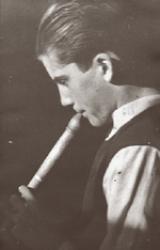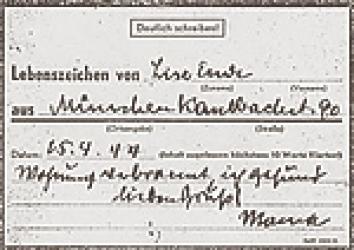The Hamburg Bombing and Poetic Beginnings
 Michael Ende in the 1940s
Michael Ende in the 1940s A ‘sign of life’ from Luise Ende, bringing news that their flat in Kaulbachstraβe had been destroyed
A ‘sign of life’ from Luise Ende, bringing news that their flat in Kaulbachstraβe had been destroyedThe horrors of war brought an early end to Michael Ende’s childhood. He was twelve years old when the first air raid took place above Munich. ‘Our street was consumed by flames. The fire didn’t crackle; it roared. The flames were roaring. I remember singing and careering through the blaze like a drunkard. I was in the grip of a kind of euphoria. I still don’t truly understand it, but I was almost tempted to cast myself into the fire like a moth into the light.’ He was horrified by the 1943 Hamburg bombing raids, which he experienced while visiting his uncle. ‘It was as though the world was coming to an end. I still dream about it now - of finding charred corpses shrivelled to the size of babies. I can picture the army of people wandering helplessly through the ruins as though trapped in a maze. One of them was carrying a table on his back - a futile gesture, but it was probably the only thing he could salvage.’
The raids began on 24th July, and by the following week Hamburg had been razed to the ground. During that time, Michael Ende was at the centre of the inferno. At the first available opportunity he was dispatched by his uncle (Edgar Ende’s brother) on a train back to Munich. At home the shaken boy composed his first poem. In 1943 schools in Munich closed as the air raids intensified and the pupils were evacuated. Michael Ende returned to his birthplace where he was billeted in a boarding-house, ‘Haus Kramerhof’ and later in ‘Haus Roseneck’. It was there that his real interest in poetry was awakened. As well as writing his own poetry, he began to study poetical movements and styles - insofar as the works were available. A good deal of modern poetry was banned at the time, and so he studied the Romantic poet Novalis, whose ‘Hymns to the Night’ left a great impression on him.
In 1944 Edgar Ende’s studio at no. 90 Kaulbachstraβe, Munich went up in flames. Over two hundred and fifty paintings and sketches were destroyed, as well as all his prints and etchings. Ernst Buchner, Director of Public Art for Bavaria, was still in possession of a number of Ende’s paintings, and they survived the raids. After the bombing Luise Ende was relocated to Solln. In 1945 Edgar Ende was taken prisoner by the Americans and released soon after the war.